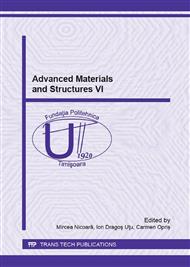p.188
p.194
p.200
p.207
p.212
p.218
p.224
p.231
p.237
Modelling of Resistance Brazing Process Using Factorial Design
Abstract:
The actual state of technological development needs to extend the brazing field of stainless steels and non-ferrous alloys based on Cu, Al, Ni, Co, Ti in leading industries, such as aerospace, energy, chemical, etc. The brazing process is influenced by a large number of parameters, which affects the quality of the joint. This paper presents a mathematical model of resistance brazing process of copper-stainless steel using a factorial experiment. The parameters considered important and which will be analyzed during this experiment are the brazing current, time and force. The output data is given by the quality of brazed joint, represented by shear strength. The objectives of this experiment are establishing the Pareto chart of the effects, the main effects of the parameters, how the response changes during the experiment when each of these factors is changed, and process optimization.
Info:
Periodical:
Pages:
212-217
Citation:
Online since:
August 2016
Authors:
Price:
Сopyright:
© 2016 Trans Tech Publications Ltd. All Rights Reserved
Share:
Citation:


